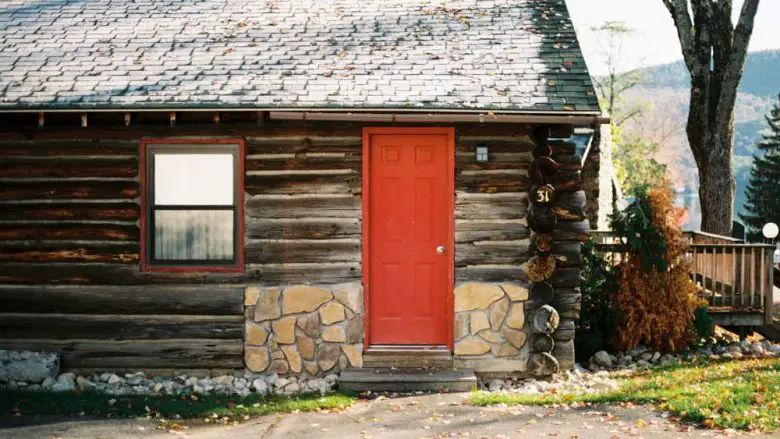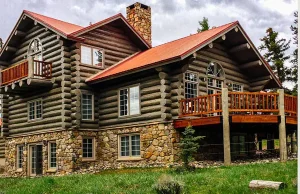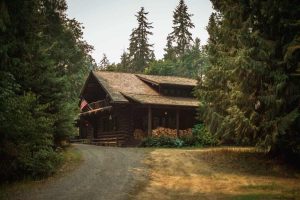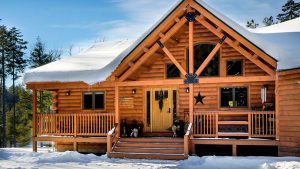Owning a log cabin is a dream for many—a cozy retreat surrounded by nature, radiating rustic charm. But that charm doesn’t maintain itself. Without proper care, your beautiful cabin can fall victim to rot, pests, and weather damage. The good news? A little regular attention goes a long way in preserving your investment and ensuring your cabin remains a safe, welcoming haven for decades.
This guide walks you through everything you need to know about log cabin maintenance. From spotting early warning signs to tackling seasonal tasks, you’ll learn how to protect your cabin from common threats and keep it looking its best year-round.
Understanding Log Cabin Enemies
Log cabins face unique challenges compared to traditional homes. The natural materials that give them their character also make them vulnerable to specific threats.
Moisture is public enemy number one. When logs absorb water, they swell, crack, and create the perfect environment for mold and rot. Poor drainage, leaky roofs, and missing chinking can all allow moisture to seep in.
Insects pose another serious risk. Carpenter bees, termites, and powder post beetles burrow into wood, weakening its structure from the inside out. You might not notice the damage until it’s already extensive.
UV rays from the sun fade and degrade wood fibers over time. Exposed logs become brittle and lose their natural oils, making them more susceptible to cracking and moisture penetration.
Temperature fluctuations cause logs to expand and contract, which can open gaps in chinking and caulking. These gaps invite moisture and pests, creating a vicious cycle of deterioration.
Understanding these enemies helps you stay one step ahead. Regular inspections and preventive measures can stop small issues before they become costly repairs.
Regular Inspection Checklist
Catching problems early saves time, money, and headaches. Schedule thorough inspections at least twice a year—once in spring and again in fall.
Start by walking around your cabin’s exterior. Look for signs of water damage, such as dark stains, soft spots, or peeling finish. Pay special attention to areas near the ground where moisture tends to accumulate.
Check the chinking and caulking between logs. Are there cracks, gaps, or missing sections? Even small openings can let in water and insects.
Examine the roof carefully. Missing or damaged shingles, moss growth, and debris buildup can all lead to leaks. Inspect gutters and downspouts to ensure they’re clear and directing water away from the foundation.
Inside your cabin, scan for water stains on ceilings and walls. These often indicate roof leaks or condensation problems. Feel for soft spots in the flooring, which may signal hidden moisture damage.
Don’t forget to inspect for insect activity. Look for small holes in the wood, sawdust-like frass, or the insects themselves. Early detection makes treatment far more effective.
Keep a maintenance log documenting your findings and any repairs made. This record helps you track recurring issues and plan future maintenance.
Essential Maintenance Tasks
Cleaning and Sealing Logs
Clean your cabin’s exterior annually using a gentle wood cleaner and soft-bristle brush. This removes dirt, mildew, and pollen that can trap moisture against the wood.
After cleaning, apply a high-quality wood sealant or stain. These products create a protective barrier against moisture and UV damage. Choose a finish with UV inhibitors for maximum protection.
Reapply sealant every two to three years, or as recommended by the manufacturer. Climate and sun exposure affect how often refinishing is needed.
Chinking and Caulking Repairs
Inspect chinking (the material filling large gaps between logs) and caulking (used for smaller gaps) regularly. Both materials shrink and crack over time.
Remove old, damaged chinking and replace it with fresh material. Modern synthetic chinking is flexible and durable, moving with the logs as they expand and contract.
For small gaps, use a high-quality acrylic latex caulk. Apply it when temperatures are moderate—between 40°F and 90°F—for best adhesion.
Addressing Wood Rot
Wood rot requires immediate attention. Use a screwdriver to test suspicious areas. If the wood feels soft or spongy, you’ve found rot.
For minor rot, remove the affected wood with a chisel or saw. Treat the area with a wood preservative, then fill it with an epoxy wood filler. Sand smooth and refinish to match the surrounding logs.
Extensive rot may require replacing entire log sections. This is typically a job for professionals who can ensure structural integrity.
Preventing Future Issues
Prevention beats cure every time. A few proactive steps can save you from major repairs down the road.
Ensure proper ventilation throughout your cabin. Good airflow prevents moisture buildup in crawl spaces, attics, and living areas. Install vents if necessary and keep them clear of obstructions.
Maintain effective drainage around your cabin’s foundation. Gutters and downspouts should direct water at least six feet away from the structure. Grade the soil to slope away from the foundation.
Apply wood preservatives to protect against insects and fungi. Borate-based treatments penetrate deep into the wood and provide long-lasting protection. Treat all exposed wood, especially near ground level.
Trim vegetation around your cabin. Overhanging branches drop moisture and debris onto the roof, while shrubs touching the walls can trap moisture against the logs. Maintain at least two feet of clearance.
Control indoor humidity with dehumidifiers if needed. Excess moisture inside the cabin can be just as damaging as rain from outside.
Seasonal Maintenance Tips
Spring
Winter can be harsh on log cabins. Once the snow melts, inspect for damage caused by ice and moisture. Check for loose or damaged chinking that may have occurred during freeze-thaw cycles.
Clean gutters and downspouts of debris that accumulated over winter. Repair any damage before spring rains begin.
This is an ideal time to apply fresh sealant if needed. The moderate temperatures and low humidity help products cure properly.
Summer
Focus on protecting your cabin from intense sun and insect activity. Ensure your UV-protective finish is intact and touch up any areas that look faded or worn.
Watch for signs of insect infestation. Carpenter bees are particularly active in summer. If you spot them, treat affected areas promptly.
Keep the area around your cabin clear of dead wood and debris that can harbor pests.
Fall
Prepare your cabin for winter by sealing any gaps in chinking and caulking. Cold air entering through cracks makes heating less efficient and can cause moisture problems.
Clear leaves and debris from gutters, downspouts, and the roof. Clean out chimneys and inspect them for damage.
Check weatherstripping around doors and windows. Replace worn strips to keep cold air out and warm air in.
Winter
Monitor your cabin for moisture buildup from condensation. Run exhaust fans when cooking or showering to reduce indoor humidity.
Watch for ice dams on the roof. These occur when heat escapes through the roof, melting snow that refreezes at the eaves. Proper insulation and ventilation help prevent ice dams.
After heavy snow, gently remove excess accumulation from the roof if it’s safe to do so. This reduces the weight load on the structure.
DIY vs. Professional Help
Many log cabin maintenance tasks are suitable for capable DIY enthusiasts. Cleaning, applying sealant, and minor chinking repairs fall into this category. These projects require patience and attention to detail but don’t demand specialized skills.
However, some situations call for professional expertise. Structural issues, extensive rot, major log replacement, and pest infestations often require trained specialists with the right tools and materials.
If you’re unsure whether you can handle a repair safely and effectively, err on the side of caution and consult a professional. The cost of expert help is typically less than fixing a botched DIY attempt.
Consider hiring a professional log home inspector for periodic comprehensive evaluations. They can spot issues you might miss and provide guidance on maintenance priorities.
Frequently Asked Questions
How often should I reseal my log cabin?
Most experts recommend resealing every two to three years, though this varies based on your climate, the product used, and sun exposure. Inspect your finish annually—if water no longer beads on the surface, it’s time to reseal.
What’s the best way to prevent insect damage?
Apply borate-based wood preservatives to all exposed logs, especially near the ground. Treat logs before applying sealant so the preservative can penetrate deeply. Keep wood piles away from your cabin and address any moisture problems that attract insects.
Can I power wash my log cabin?
Use extreme caution with power washers. High pressure can damage wood fibers and force water deep into the logs. If you choose to power wash, use the lowest effective pressure setting and keep the nozzle at least 12 inches from the surface.
How do I know if my cabin needs new chinking?
Inspect chinking carefully for cracks, gaps, or areas where it’s pulling away from the logs. If you can see daylight through gaps or feel air movement, replacement is needed. Chinking should be flexible yet firmly adhered to the wood.
Is it normal for logs to crack?
Yes, checking (small surface cracks) is a natural part of the log drying process. These cracks rarely affect structural integrity. However, large splits that penetrate deep into the log may need filling to prevent moisture and insect entry.
Protect Your Investment with Consistent Care
A well-maintained log cabin can last for generations, providing comfort and beauty through decades of memories. The key lies in staying vigilant and addressing issues promptly before they escalate into major problems.
By following the inspection schedule, tackling essential maintenance tasks, and adapting your care routine to each season, you’ll keep your cabin in excellent condition. Remember that prevention is always easier and less expensive than repair.
Don’t wait for problems to become obvious. Start implementing these maintenance practices today, and your log cabin will reward you with years of reliable service and timeless appeal.




